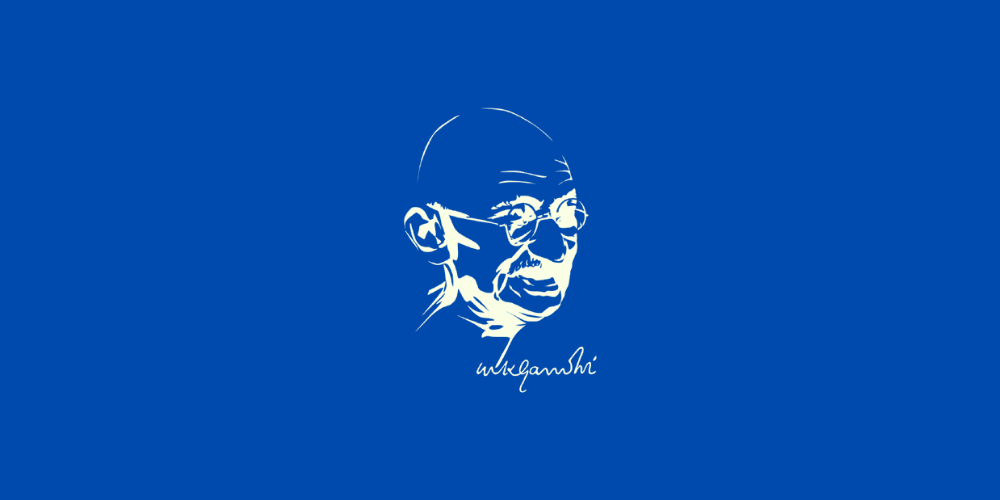Table of Contents Show
Mohandas Karamchand Gandhi, more commonly known as ‘Mahatma’ (meaning ‘Great Soul’) was born in Porbandar, Gujarat, in North West India, on 2nd October 1869, into a Hindu Modh family. His father was the Chief Minister of Porbandar, and his mother’s religious devotion meant that his upbringing was infused with the Jain pacifist teachings of mutual tolerance, non-injury to living beings and vegetarianism.
BIOGRAPHY

NAME
Mahatma Gandhi
FULL NAME
Mohandas Karamchand Gandhi
BIRTH DATE
October 2, 1869
PLACE OF BIRTH
Porbandar, Kathiawar, India
EDUCATION
Samaldas College at Bhavnagar, Gujarat, University College London
ALMA MATER
- Alfred High School, Rajkot (1880 – November 1887)
- Samaldas Arts College, Bhavnagar (January 1880 – July 1888)
- Inner Temple, London (September 1888–1891)
- (Informal auditing student at University College, London between 1888 and 1891)
OCCUPATION
Lawyer, anti-colonial nationalist, political ethicist
PARENTS
Karamchand Gandhi (father)
Putlibai Gandhi (mother)
SPOUSE’S / WIFE
Kasturba Gandhi (Born 11April 1869; Died 1944)
Marriage – May, 1883
CHILDRENS
- Harilal
- Manilal
- Ramdas
- Devdas
YEARS ACTIVE
1893–1948
MOVEMENT
Indian independence movement
POLITICAL PARTY
Indian National Congress (1920–1934)
KNOWN FOR
Leadership of the campaign for India’s independence from British rule, Nonviolent resistance
SOMETHING DIFFERENT TO KNOW ABOUT MK GANDHI
1. As a young man, Mahatma Gandhi was a poor student and was terrified of public speaking.
2. Gandhi formed the Natal Indian Congress in 1894 to fight discrimination.
3. Gandhi was assassinated by Hindu extremist Nathuram Godse, who was upset at Gandhi’s tolerance of Muslims.
4. Gandhi’s non-violent civil disobedience inspired future world leaders like Martin Luther King Jr. and Nelson Mandela.
DEATH DATE
January 30, 1948 (aged 78)
PLACE OF DEATH
New Delhi, India
CAUSE OF DEATH
Assassination (Gunshot wounds)
MONUMENTS
Raj Ghat, Gandhi Smriti
Mahatma Gandhi | Religion and Beliefs
Gandhi grew up worshiping the Hindu god Vishnu and following Jainism, a morally rigorous ancient Indian religion that espoused non-violence, fasting, meditation and vegetarianism.
During Gandhi’s first stay in London, from 1888 to 1891, he became more committed to a meatless diet, joining the executive committee of the London Vegetarian Society, and started to read a variety of sacred texts to learn more about world religions.
Living in South Africa, Gandhi continued to study world religions. “The religious spirit within me became a living force,” he wrote of his time there. He immersed himself in sacred Hindu spiritual texts and adopted a life of simplicity, austerity, fasting and celibacy that was free of material goods.
Mahatma Gandhi in South Africa
When Gandhi arrived in South Africa, he was quickly appalled by the discrimination and racial segregation faced by Indian immigrants at the hands of white British and Boer authorities. Upon his first appearance in a Durban courtroom, Gandhi was asked to remove his turban. He refused and left the court instead. The Natal Advertiser mocked him in print as “an unwelcome visitor.”
After a brief trip to India in late 1896 and early 1897, Gandhi returned to South Africa with his wife and children. Gandhi ran a thriving legal practice, and at the outbreak of the Boer War, he raised an all-Indian ambulance corps of 1,100 volunteers to support the British cause, arguing that if Indians expected to have full rights of citizenship in the British Empire, they also needed to shoulder their responsibilities.
Return to India
When Gandhi sailed from South Africa in 1914 to return home, Smuts wrote, “The saint has left our shores, I sincerely hope forever.” At the outbreak of World War I, Gandhi spent several months in London.
In 1915 Gandhi founded an ashram in Ahmedabad, India, that was open to all castes. Wearing a simple loincloth and shawl, Gandhi lived an austere life devoted to prayer, fasting and meditation. He became known as “Mahatma,” which means “great soul.”
Opposition to British Rule in India
In 1919, with India still under the firm control of the British, Gandhi had a political reawakening when the newly enacted Rowlatt Act authorized British authorities to imprison people suspected of sedition without trial. In response, Gandhi called for a Satyagraha campaign of peaceful protests and strikes.
Gandhi became a leading figure in the Indian home-rule movement. Calling for mass boycotts, he urged government officials to stop working for the Crown, students to stop attending government schools, soldiers to leave their posts and citizens to stop paying taxes and purchasing British goods.
Gandhi assumed the leadership of the Indian National Congress and advocated a policy of non-violence and non-cooperation to achieve home rule.
After British authorities arrested Gandhi in 1922, he pleaded guilty to three counts of sedition. Although sentenced to a six-year imprisonment, Gandhi was released in February 1924 after appendicitis surgery.
Gandhi and the Salt March
Wearing a homespun white shawl and sandals and carrying a walking stick, Gandhi set out from his religious retreat in Sabarmati on March 12, 1930, with a few dozen followers. By the time he arrived 24 days later in the coastal town of Dandi, the ranks of the marchers swelled, and Gandhi broke the law by making salt from evaporated seawater.
The Salt March sparked similar protests, and mass civil disobedience swept across India. Approximately 60,000 Indians were jailed for breaking the Salt Acts, including Gandhi, who was imprisoned in May 1930.
Gandhi was released from prison in January 1931, and two months later he made an agreement with Lord Irwin to end the Salt Satyagraha in exchange for concessions that included the release of thousands of political prisoners.
Hoping that the agreement would be a stepping-stone to home rule, Gandhi attended the London Round Table Conference on Indian constitutional reform in August 1931 as the sole representative of the Indian National Congress. The conference, however, proved fruitless.
From Mohan to Mahatma
It has been seventy years since Mahatma Gandhi departed from our midst. But his life and soul continue to animate humanity transcending national and international boundaries. His contribution to human development is far too great and varied to have been forgotten or to be overlooked. The world today recognizes him as a far more compelling social innovator than humanity ever realized.
The life of Mohandas Karamchand Gandhi is a story of heroic effort to establish the values of Truth and Non-violence in human life. In pursuing this objective Gandhiji became a Mahatma from a mere ‘Monya’. He became a messenger, for the people of the world surrounded by fire of violence in the twentieth century. He also became ‘The Father of The Nation’. He saved India and Britain from mutual hate and revenge by resorting to the experiment of Truth and Non-violence in India’s struggle for freedom. This created an atmosphere which made it possible for other countries of Asia and Africa to free themselves without bloodshed from the hold of the European countries which had subdued them in the nineteenth century.
Being born in a middle class Vaishnava family and brought up in that atmosphere till he joined school and received instruction according to the system then prevailing, he lived, dressed and dined in the way all children of that class did. Later, he went to England for studies and changed his dress to suit the conditions of that country. But in food and certain other matters, he remained true to the lesson he had learnt early in life. On his return to India after being called to the Bar, he passed through difficult times as all beginners in the profession of the law have to do and it was as a lawyer that he went to South Africa to help a client. He had, however, to spend many years there as the condition of Indians and the treatment they received demanded that he should serve them rather than return to India. His struggle with the authorities brought about a considerable change in his life and by the time he returned to India, he had already become a Mahatma. His dress in India on his return was different from what he used to wear when he was practicing as a Barrister and conformed to the old Kathiawadi type.
If in South Africa it was the Railway Ticket Collector who paved the way for the birth of a Satyagrahi, in India it was a poor peasant from Champaran, Rajkumar Shukla, who provided him a platform to test the power of Satyagraha on the Indian soil. His campaign in favour of the non-co-operation movement brought about another change which identified his outward appearance with that of the humblest and lowliest of the land and he stuck to the loin cloth till he departed with the name of God on his lips.
Mahatma Gandhi was imprisoned several times in his pursuit of non-cooperation and undertook many ‘fasts’ to protest against the oppression of the down trodden in India.
He invented the techniques of mass –civil disobedience in South Africa which were later emulated in India and across the world.
On January 30th, 1948, the assassin’s bullet ended the physical existence of Mahatma Gandhi and made him immortal who left an indelible legacy to the mankind –‘My life is my Message’.
India’s Independence from British Colonism
As Great Britain found itself engulfed in World War II in 1942, Gandhi launched the “Quit India” movement that called for the immediate British withdrawal from the country. In August 1942, the British arrested Gandhi, his wife and other leaders of the Indian National Congress and detained them in the Aga Khan Palace in present-day Pune.
With his health failing, Gandhi was released after a 19-month detainment in 1944.
After the Labour Party defeated Churchill’s Conservatives in the British general election of 1945, it began negotiations for Indian independence with the Indian National Congress and Mohammad Ali Jinnah’s Muslim League. Gandhi played an active role in the negotiations, but he could not prevail in his hope for a unified India. Instead, the final plan called for the partition of the subcontinent along religious lines into two independent states—predominantly Hindu India and predominantly Muslim Pakistan.
Violence between Hindus and Muslims flared even before independence took effect on August 15, 1947. Afterwards, the killings multiplied. Gandhi toured riot-torn areas in an appeal for peace and fasted in an attempt to end the bloodshed. Some Hindus, however, increasingly viewed Gandhi as a traitor for expressing sympathy toward Muslims.
Assassination of Mahatma Gandhi
On January 30, 1948, 78-year-old Gandhi was shot and killed by Hindu extremist Nathuram Godse, who was upset at Gandhi’s tolerance of Muslims. Godse and a co-conspirator were executed by hanging in November 1949. Additional conspirators were sentenced to life in prison.
Gandhi’s memorial bears the epigraph “Hé Rām” (“Oh God”) although there is no conclusive proof that he uttered these words before death.
Although Gandhi was nominated for the Nobel Peace Prize five times, he never received it. In the year of his death, 1948, the Prize was not awarded, the stated reason being that “there was no suitable living candidate” that year.
Gandhi’s life and teachings have inspired many liberationists of the 20th Century, including Dr. Martin Luther King in the United States, Nelson Mandela and Steve Biko in South Africa, and Aung San Suu Kyi in Myanmar.
His birthday, 2nd October, is celebrated as a National Holiday in India every year.





